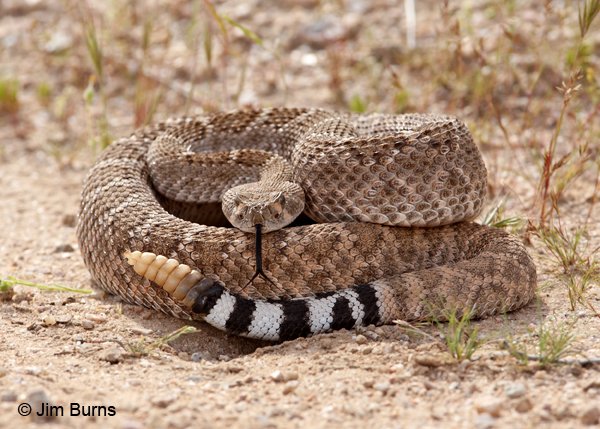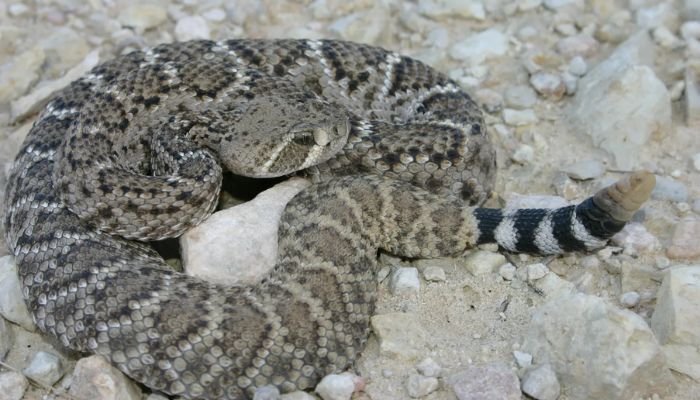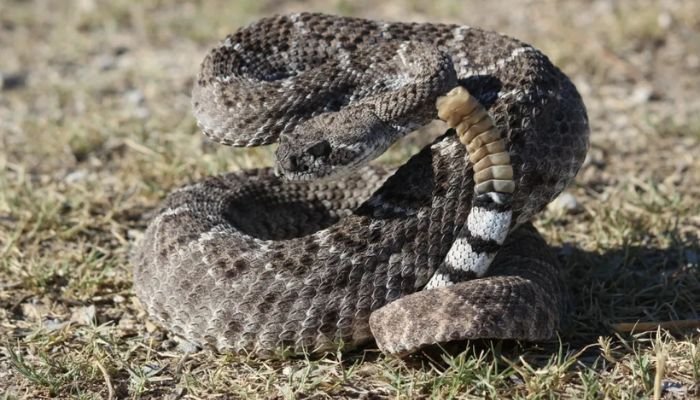
Western diamondback rattlesnake The Western Diamondback Rattlesnake is a variety of poisonous snake that is native to the southwestern United States and northern Mexico. Due to its menacing rattling and striking diamond-shaped patterns, it is a recognizable symbol of the American Southwest. Western Diamondbacks call a variety of habitats their home, including deserts, grasslands, and rugged terrains. Although their venom is potentially lethal to humans, these snakes are essential for rodent control.. Here are Western diamondback rattlesnake Guide on Food, Habitat, Size, Lifespan & Predators below-
Western diamondback rattlesnake Stats in Table format
The stats are given below for Western diamondback rattlesnake
| Reptiles List | Western diamondback rattlesnake |
|---|---|
| Family | Viperidae |
| Type | Snake |
| Size | Large |
| Length | Western diamondback rattlesnake: Up to 3-5 feet (0.9-1.5 meters) |
| Color | Western diamondback rattlesnake: The color varies depending on the subspecies, but western diamondback rattlesnakes can have shades of brown, gray, or pinkish with darker diamond-shaped patterns. |
| Weight | Western diamondback rattlesnake: The weight varies depending on the size and age of the Western diamondback rattlesnake, but adults can weigh between 3 to 7 pounds or more.. |
| Lifespan | 10-20 years (or more) |
| Reproduction | Ovoviviparous, gives birth to live young |
| Gestation Periods | Gestation period: Approximately 90-100 days |
| Endangered Status | Least Concern (IUCN Red List) |
| Features | Rattle on the tail, venomous bite |
| Country & Areas | United States, Mexico, and parts of Central America. |
Western Diamondback Rattlesnake Natural Habitat and Distribution
Venomous pit vipers, like the Western Diamondback Rattlesnake (Crotalus atrox), are native to North America. It’s one of the most common rattlesnakes in the country, and its reputation precedes it. Deserts, grasslands, scrublands, and open forests are all part of the snake’s natural environment. They thrive in the warm weather of the southwestern United States and Mexico. This includes states like Texas, Arizona, New Mexico, Nevada, and southern California.
Western Diamondback Rattlesnake Physical Features and Adaptations
Here are some information about Western diamondback rattlesnake:
1. Body Structure
The Western diamondback rattlesnake has a sturdy and muscular build, which aids in its ability to hunt and strike. Some adult Western Diamondbacks can grow to be as long as 7 feet, while the typical adult is closer to 3 feet. Women typically weigh more than men. Their large skulls protect the venom-injecting fangs that they utilize to capture and immobilize victims.
2. Coloration and Patterns
The snake’s patterning and coloring help it blend in with its surroundings in the wild. Light brown or gray to pinkish brown is a common background color, and they frequently have black diamond-shaped spots running the length of their bodies, which are bordered in lighter scales. The Western Diamondback’s ability to blend into its environment, thanks to its contrasting colors and patterns, makes it less noticeable to both predators and prey.
3. Defense Mechanisms
The rattle at the end of the tail is part of the highly evolved defense mechanism that all rattlesnakes, including the Western Diamondback, have. When threatened, they make a characteristic rattling noise by rapidly vibrating their tails. For other animals, this is a warning to keep their distance and avoid conflict. If the warning is disregarded, however, the Western Diamondback may use venom from its teeth to incapacitate or even kill the perceived threat.
Western Diamondback Rattlesnake Diet and Feeding Habits
Here are some information about Western diamondback rattlesnake:Diet and Feeding Habits
1. Diet Type
Carnivorous by nature, Western Diamondback Rattlesnakes subsist mostly on prey such as rodents and birds. As both predators and prey, they play an important role in maintaining healthy rodent populations in their natural environments.
2. Preferred Food Sources
Mice, rats, and ground squirrels are the Western Diamondback Rattlesnake’s principal food sources. On the other hand, they are opportunistic feeders and will take advantage of the chance to eat anything from lizards to other snakes. Rattlesnakes’ diets can change depending on their size, age, and the availability of food in their habitat.
3. Feeding Schedule
Rattlesnakes are nocturnal, ambush predators that wait for their prey to move out of sight before attacking. Because of their slow metabolism, they don’t have to eat very often. They can go weeks or even months without eating after a successful hunt, depending on conditions like the weather and the size of their last meal.
Western Diamondback Rattlesnake Housing and Enclosure Requirements
Here are some information about Western diamondback rattlesnake:
1. Terrarium Size and Setup
Keeping a Western Diamondback Rattlesnake in captivity requires an environment that is as close as possible to the snake’s native habitat. The minimum dimensions for an enclosure housing an adult Western Diamondback tarantula are six feet in length, three feet in width, and two feet in height. A tight-fitting cover of the enclosure is necessary for containment purposes.
2. Substrate Options
Consider using a substrate that is representative of the snake’s native habitat. Aspen shavings, cypress mulch, and paper substrate are all good choices. To keep the snake healthy and happy, the substrate should be simple to clean and maintain.
3. Temperature and Lighting
Because of its warm-blooded origins, a captive Western Diamondback’s enclosure must be heated and well-lit. The temperature inside the cage should range from around 85 to 90 degrees Fahrenheit (29 to 32 degrees Celsius) at one end to about 75 to 80 degrees Fahrenheit (24 to 27 degrees Celsius) at the other. The snake is therefore able to keep its internal temperature stable.
The snake’s natural circadian cycle depends on the presence of light. It is suggested that a light source be provided and set on a timer to simulate a day/night cycle of 12 hours.
4. Humidity and Water Needs
Although Western Diamondback Rattlesnakes thrive in dry conditions, a humidity range of 40-50% is recommended for optimal health and shed frequency. In addition to food and water, a snake needs a shallow water dish big enough for it to bathe in while it sheds.
Western Diamondback Rattlesnake Behaviour and Temperament
Here are some information about Western diamondback rattlesnake:

1. Activity Levels
Because it is a cold-blooded reptile, the Western Diamondback Rattlesnake’s body temperature varies with its environment and its level of activity. Since they are ectotherms, environmental temperature affects their activity levels. When temperatures soar, you could spot one lazing in the sun to get a head start on the day. In contrast, they frequently take refuge in burrows or under rocks during colder or hotter weather. Because of their preference for cooler temperatures, they are predominantly crepuscular or nocturnal, being most active around dawn and dusk or at night.
2. Social Behaviour
The Western Diamondback rattlesnake is typical of the solitary nature shared by most rattlesnakes. They do not have elaborate social structures or close-knit communities. However, several males may vie for the attention of a single female during mating season. Males may resort to fighting in order to assert their control in these situations. Except during breeding seasons or random encounters during their regular activity, rattlesnakes like to keep to themselves and their own territory.
3. Handling and Taming
It is important to stress that the general people should not attempt to handle or tame rattlesnakes, particularly the Western Diamondback. Because of their untamed nature and the potency of their venom, rattlesnakes can be quite dangerous. Biting and injecting venom is their primary defense method, and this habit may persist even in captive-bred animals. Taming a rattlesnake is not only dangerous, but it may also be stressful for the snake, which can have negative effects on the handler. Only qualified specialists, such as herpetologists or poisonous snake handlers, who are familiar with proper safety procedures should handle venomous snakes.
Western Diamondback Rattlesnake Breeding and Reproduction
Here are some information about Western diamondback rattlesnake:
1. Mating and Courtship Rituals
Western Diamondback Rattlesnakes engage in mating and courtship rituals in the spring after emerging from their winter hibernation. Males grow more aggressive and may even fight for the privilege to mate with fertile females during this time. In order to attract a mate, males perform elaborate courtship rituals that may include tongue flicking, body motions, and the emission of pheromones. A couple may spend hours in wooing before finally mating. When a female is fertilized, she stores the sperm inside her until the time is right for ovulation and egg laying.
2. Incubation and Hatchlings
Western Diamondback Rattlesnake Eggs and Baby Rattlesnakes The female rattlesnake is ovoviviparous, meaning she incubates her eggs inside her own body. The length of the gestation period varies by species and location, although it typically takes a few months. The female gives birth to a litter of anything from four to twenty-five completely formed young, all of whom survive. Baby rattlesnakes are born with poisonous fangs and the ability to survive on their own. They are abandoned shortly after birth and left to fend for themselves.
Western Diamondback Rattlesnake Common Health Issues and Veterinary Care
Here are some information about Western diamondback rattlesnake:
1. Respiratory Infections
Captive Western Diamondback Rattlesnakes are susceptible to respiratory diseases if the temperature and humidity of their enclosure are too low or too high. Wheezing, hard breathing, nasal discharge, and loss of appetite are all possible signs of a respiratory illness. If these signs are present, quick veterinarian care is required. Respiratory problems can be avoided with good husbandry practices, such as keeping the temperature and humidity stable.
2. Parasites
Parasites: Western diamondback rattlesnakes, like many other reptiles, are susceptible to both internal and exterior parasites. Intestinal worms and other forms of internal parasites can disrupt digestion and lead to a loss of body mass. Skin irritation and subsequent infections can result from external parasites like mites on a snake. In order to monitor and treat parasite infestations, routine fecal examinations and preventative actions are required.
3. Metabolic Bone Disease
Western Diamondback Rattlesnakes are susceptible to a condition known as metabolic bone disease (MBD), which is caused by a lack of calcium and vitamin D3 in the food and a lack of availability to these nutrients. Bone weakness, deformities, and trouble moving are all potential outcomes of MBD. Preventing this disease requires a balanced diet and adequate UVB lighting for captive animals.

Importance of Regular Vet Check-ups
Captive Western Diamondback Rattlesnakes require consistent visits to the vet to ensure their health and well-being. Despite appearances, many reptile health problems are asymptomatic until they reach a critical stage. A trained reptile vet can undertake diagnostic tests and a full physical examination to identify any health issues. In addition, they can offer guidance on how to best care for the snake in terms of husbandry, diet, and enclosure design.
Conclusion:
The Western diamondback rattlesnake is a fascinating and iconic reptile because of its unusual traits, body structure, and methods of reproduction. Although they are vital members of their own ecosystems, poisonous animals make poor pets for the general public due to their unpredictable behavior and complex needs. These snakes should not be handled or tamed by anyone without proper training and safety equipment.
Prioritizing the health and well-being of venomous snakes or other reptiles in captivity is an absolute necessity. Responsible pet ownership includes doing things like making sure the animal always has a clean and safe enclosure, feeding it balanced food, and taking it to the vet regularly. Furthermore, it is crucial to preserve the survival and ecological relevance of these creatures by supporting conservation efforts and appreciating them in their native habitats.
FAQs
Q: What is the family and type of a Western diamondback rattlesnake?
The Western diamondback rattlesnake, Crotalus atrox, is a member of the viper family.
Q: What is the average size of a Western diamondback rattlesnake?
Western diamondback rattlesnakes are typically between three and four feet in length. A few, though, have the potential to develop into giants.
Q: How long can a Western diamondback rattlesnake grow in size and length?
A: The average length of a Western diamondback rattlesnake is 4.5 feet, but there have been reports of snakes as long as 6 feet.
Q: What colors do Western diamondback rattlesnakes come in?
Most Western diamondback rattlesnakes have a shade of brown that falls between gray and light brown. Their backs are covered in a sequence of diamond-shaped patterns that can range in color from light gray to deep brown. They have a rattle at the end of their tail, which is banded black and white.
Q: How big can a Western diamondback rattlesnake get in weight?
The weight of an adult Western diamondback rattlesnake can vary from 2 to 10 pounds.
Q: How long do Western diamondback rattlesnakes live?
The average lifespan of a wild Western diamondback rattlesnake is between 10 and 20 years.
Q: How do Western diamondback rattlesnakes give birth?
This is because the female Western diamondback rattlesnake is ovoviviparous, meaning she gives birth to fully developed babies. Instead of hatching from eggs laid outside the body, females carry the maturing eggs within, and the resulting young are born alive.
Q: How long is the gestation period for a Western diamondback rattlesnake?
Western diamondback rattlesnakes have a gestation period of about 4–6 months.
Q: Is the Western diamondback rattlesnake endangered?
The Western diamondback rattlesnake is not an endangered species as of my most recent check in September 2021. The loss of habitat and interference from humans, however, pose risks to their populations.
Q: What are the prey of Western diamondback rattlesnakes?
Small mammals including rats, mice, rabbits, ground squirrels, and even birds make up the bulk of the diet of Western diamondback rattlesnakes. They have been observed devouring insects and even other reptiles.
Q: Do Western diamondback rattlesnakes have any predators?
Answer: Western diamondback rattlesnakes are preyed upon by other animals. Large birds of prey like hawks and eagles, as well as other carnivorous creatures like coyotes and larger snakes, are some of their natural predators.
Q: How fast does a Western diamondback rattlesnake move?
Even though western diamondback rattlesnakes are slow, they are capable of surprising bursts of speed. They have been clocked going as fast as 2.3 miles per hour.
Q: What is the bite force of a Western diamondback rattlesnake in PSI?
A: It is difficult to exactly estimate the bite force of a Western diamondback rattlesnake. However, their biting force is substantial, which helps them deliver venom into their prey, just like other venomous snakes.
Q: Can we keep Western diamondback rattlesnakes as pets?
Due to their venom and propensity for harm, Western diamondback rattlesnakes are not a good pet choice and may be outlawed in many areas. If you’re interested in reptile companionship, it’s important to emphasize safety and conservation by viewing these animals in their native habitats or finding non-venomous snakes as pets.
Q: Are Western diamondback rattlesnakes good for pest control?
Since western diamondback rattlesnakes prey on rats and mice, which can be a problem in some areas, they do help keep rodent numbers in check. But keep in mind that they are still wild creatures and shouldn’t be chased after for the sake of pest management.
Q: Are Western diamondback rattlesnakes good for pest control?
No, a UVB light source is not necessary for Western diamondback rattlesnakes. They don’t need UVB light for basic bodily functions like vitamin D production like certain reptiles do. They have specific needs in terms of environment, temperature, and diet.
I hope you like reading on Western diamondback rattlesnake FAQ Guide on Food, Habitat, Size, Lifespan and Predators.
